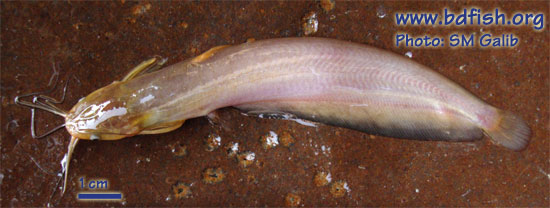
Systematic position
Phylum: Chordata
Class: Actinopterygii (Ray-finned fishes)
Order: Siluriformes (Catfishes)
Superfamily: Siluroidea
Family: Heteropneustidae (Saccobranchidae; Airsac catfishes)
Genus: Heteropneustes
Species: H. fossilis
Common/local names
English: Stinging catfish
Bangladesh: Shing (শিং), Shinghi (শিংঘি) and Jiol (জিওল)
India: Singee and Sheenee (Assam); Singhi (West Bengal); Singhi (Bihar); Kamacha-singhi, Bitchu, Tailia and Singee (Uttar Pradesh); Lahoord and Nullie (Punjab); Singee and Singhi (Orissa); Ingilayee, Mapujella and Marpu (Andhra Pradesh); Thaylee and Thalimeen (Tamil Nadu); Kahree-meen, Kadu, Moyya and Kari (Kerala); Kappethede, Kappershode, Seruva and Sinimeen (Karnataka); Bitchuka-machi (Maharashtra); and Singhi (Gujrat) (Talwar and Jhingran, 1991).
Synonyms
Saccobranchus fossilis (Bloch, 1794)
Saccobranchus microcephalus Günther, 1864
Saccobranchus singio (Hamilton, 1822)
Silurus biserratus Swainson, 1839
Silurus fossilis Bloch, 1794
Silurus laticeps Swainson, 1838
Silurus singio Hamilton, 1822
Distributions: Bangladesh, India (including Andaman Island), Laos, Myanmar, Nepal (?), Pakistan (Indus basin), Sri Lanka and Thailand (Talwar and Jhingran, 1991)
Conservation status: Not threatened in Bangladesh (IUCN Bangladesh, 2000).
Morphology: Body elongate and compressed. Depressed head covered with osseous plate at top and sides of the head. Barbels four pairs in which maxillary pairs extend to end of pectorals or to commencement to anal and mandibular pairs extend upto base of pelvics but nasal pair considerably shorter than mandibular pairs. Outstanding anatomical feature is a pair of accessory respiratory organ (air sacs) which extends backwards from the gill-chamber on either side of vertebral column. Caudal rounded.
Head 6.0-6.5 in standard, 6.8-7.2 in total length. Height 5.8-6.3 in standard, 6.4-7.0 in total length. Gape 2.5-3.2 in head, eye 6.09.5, snout 2.6-3.4, interorbital 3.5-5.0 (Rahman, 1989). Body color reddish brown or purplish brown but in mature stage of specimens it shows black in color.
Fin formula:
D. 7; V. 6; A. 70; C. 19 (Bhuiyan, 1964)
D. 6-7; P1. 1/6-7; P2. 6; A. 62-70 (Rahman, 1989 and 2005)
D 6-7; A 60-70; P I 7; V i 5 (Talwar and Jhingran, 1991)
D. 7; P. 7; V. 6; A. 6-79; C. 19 (Shafi and Quddus, 2001)
Maximum lengths: 30 cm (Bhuiyan, 1964; Talwar and Jhingran, 1991; Shafi and Quddus, 2001) and 27.9 cm (Rahman, 1989 and 2005).
Habitats: Very common in pond, ditches, swamps and marshes but found in muddy river also. Recorded from the Chalan beel (Galib et al., 2009 and 2010); Padma river in Rajshahi (Samad et al., 2010).
Food and feeding: Mollusks 15.5%, Cypris 15.6% , Chironomid larvae 13.4%; fish and its scales 11.1%, eggs of invertebrates 13.2%, copepod 16.5%, weeds 20.3%, detritus 41.0%, and fungus and others 16.3% (Shafi and Quddus, 2001).
Body composition: Each 100 g contains- protein 23.0 g, fat 0.6 g, calcium 670 mg, phosphorus 650 mg and water 79.3% (Siddique, 1996).
Spawning: Attains sexual maturity at one year of age when male is generally 5.5 cm and female is 12 cm (Talwar and Jhingran, 1991). Induced breeding is recorded in hatcheries of Jessore district, Bangladesh (Galib, 2011).
Fertilized eggs are green (Bhuiyan, 1964), adhesive, demersal and spherical in form (Talwar and Jhingran, 1991). Fecundity was measured 2,843 to 44,724 (Shafi and Quddus, 2001).
Fishery info: Used as food fish in Bangladesh. High economic importance and of great demand because of medicinal value (Talwar and Jhingran, 1991). Recommended for patients after recovery from malaria for its invigorating qualities (Bhuiyan, 1964). Always marketed in live condition.
Others: Much dreaded because of its aggressive behavior and can inflict painful wounds with its pectoral spines (Talwar and Jhingran, 1991).
__________________________________________________________
REFERENCES
Bhuiyan AL (1964) Fishes of Dacca, Asiat. Soc. Pakistan, Pub. 1, No. 13, Dacca, pp. 80-82.
Bloch ME (1794) Naturgeschichte der ausländischen Fische. Berlin. Naturgeschichte der Ausländischen Fische. v. 8: i-iv + 1-174, Pls. 361-396.
Galib SM (2011) Non-traditional fish seeds for aquaculture, Bangladesh Fish. Info. Share Home, ISSN 2224-0608, retrieved on September 07, 2011.
Galib SM, Samad MA, Hossain MA, Mohsin ABM and Haque SMM (2010) Small Indigenous Species of Fishes (SISF) in Chalan Beel with Reference to their Harvesting and Marketing, Bangladesh Journal of Progressive Science and Technology, 8(2): 251-254.
Galib SM, Samad MA, Mohsin ABM, Flowra FA and Alam MT (2009) Present Status of Fishes in the Chalan Beel- the Largest Beel (Wetland) of Bangladesh, Int. J. Ani. Fish. Sci. 2(3):214-218.
Günther A (1864) Catalogue of the fishes in the British Museum. Catalogue of the Physostomi, containing the families Siluridae, Characinidae, Haplochitonidae, Sternoptychidae, Scopelidae, Stomiatidae in the collection of the British Museum. Catalogue of the fishes in the British Museum. 5: i-xxii + 1-455.
Hamilton F (1822) An account of the fishes found in the river Ganges and its branches. Edinburgh & London. An account of the fishes found in the river Ganges and its branches.: i-vii + 1-405, Pls. 1-39.
IUCN Bangladesh (2000) Red book of threatened fishes of Bangladesh, IUCN- The world conservation union. xii+116 pp.
Rahman AKA (1989) Freshwater Fishes of Bangladesh, 1st edition, Zoological Society of Bangladesh, Department of Zoology, University of Dhaka, Dhaka-1000, pp. 170-171.
Rahman AKA (2005) Freshwater Fishes of Bangladesh, 2nd edition, Zoological Society of Bangladesh, Department of Zoology, University of Dhaka, Dhaka-1000, pp. 189-191.
Shafi M and Quddus MMA (2001) Bangladesher Matsho Shampad (Fisheries of Bangladesh) (in Bengali), Kabir publication. Dhaka, Bangladesh. pp. 231-239.
Siddiqui K and Choudhury SN (1996) A Manual on Pond Pisciculture, The National Institute of Local Government, Dhaka, Bangladesh, p. 104.
Swainson W (1839) The natural history and classification of fishes, amphibians, & reptiles, or monocardian animals. Spottiswoode & Co., London. Nat. Hist. & Class. i-vi + 1-448.
Talwar PK and Jhingran AG (1991) Inland Fishes of India and Adjacent Countries, Vol. 2, Oxford & IBH Publishing Co. Pvt. Ltd. New Delhi-Calcutta, pp. 689-690.
Visited 30,840 times, 1 visits today | Have any fisheries relevant question?
